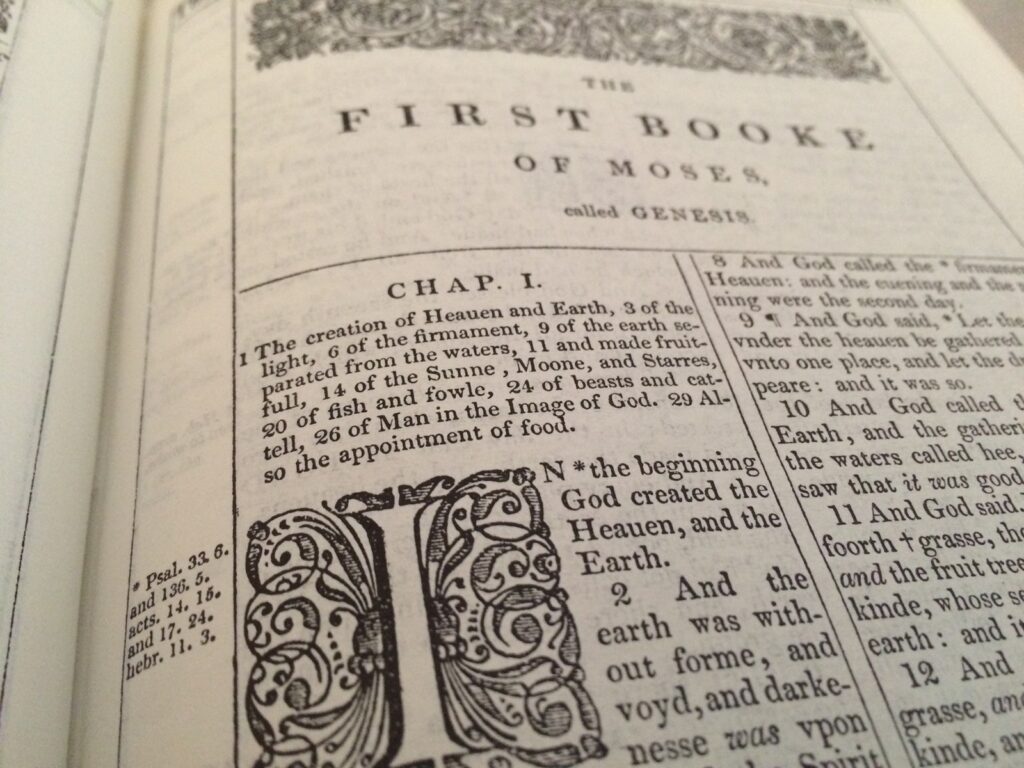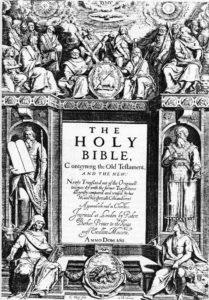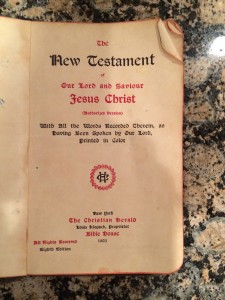I was happy to have the opportunity to talk about 35+ years of developing Bible software, starting at home, then at Parsons Technology, then at Laridian. Check out biblebuyingguide.com for reviews of Bibles and other materials related to reading and studying the Bible.
Happy Candlemas! (Groundhog Day)

Groundhog Day, celebrated on February 2nd, has its roots in an ancient Christian tradition known as Candlemas Day, which marks the midpoint between the winter solstice and the spring equinox. On Candlemas Day, clergy would bless and distribute candles needed for winter, and the candles represented how long and cold the winter would be.
The choice of February 2nd is rooted in early Christian tradition and Jewish custom, which mandated a period of purification for a mother after giving birth, followed by the presentation of the child at the Temple. For a male child, this period was 40 days, and since Jesus’s birth is celebrated on December 25th, the 40th day thereafter is February 2nd.
The weather lore associated with Candlemas, however, has pre-Christian roots.
Pre-Christian Traditions
The tradition of observing weather patterns around the beginning of February can be traced back to pre-Christian times and is linked to ancient Celtic festivals, particularly Imbolc. Imbolc is celebrated on February 1st and marks the beginning of spring in the Celtic calendar. It was a time for weather divination, and the weather on Imbolc was thought to predict the weather for the coming spring and the remainder of winter. This period, falling halfway between the winter solstice and the spring equinox, was a significant seasonal marker in many ancient agrarian cultures.
Candlemas and Weather Lore
When Christianity spread throughout Europe, many pagan traditions were Christianized or absorbed into Christian celebrations. Candlemas became one such feast where pre-existing weather lore was integrated into Christian practice. Sunny weather on February 2nd indicated more winter to come, similar to the Groundhog Day belief that if the groundhog sees its shadow, there will be six more weeks of winter.
This lore found expression in various regional aphorisms:
England
If Candlemas be fair and bright,
Winter has another flight.
If Candlemas brings clouds and rain,
Winter will not come again.
Scotland
If Candlemas Day is bright and clear,
There’ll be two winters in the year.
Germany
For as the sun shines on Candlemas Day,
So far will the snow swirl until May.
For as the snow blows on Candlemas Day,
So far will the sunshine before May.
America
If the sun shines on Groundhog Day;
Half the fuel and half the hay.
Germanic Influence and the Emergence of the Groundhog Tradition
The specific tradition of using an animal to predict the weather on this day is more directly traceable to Germany and surrounding regions. Before the tradition was brought to North America, Germans looked to the badger as a weather prognosticator. When German settlers arrived in North America, particularly in Pennsylvania, they adapted the tradition to use the groundhog due to the absence of badgers in their new homeland.

Alphabetic Weirdness

I’ve spent the last 45 years manipulating text and creating digital books and Bibles. This has resulted in an interest in (or at least familiarity with) the history of the English language, the English alphabet, the nature and limitations of translating from one language to another, and all manner of other esoteric questions of orthography (spelling), grammar, and vocabulary.
I frequently have to interact with Christians who have deeply held beliefs about the superiority of the 1611 “Authorized Version” of the Bible — otherwise known as the King James Version. I’ve written at length about our history with (and the history of) the KJV text. Today I want to talk about a few oddities you’ll find in the first editions of the KJV. These demonstrate weird aspects in the history of our alphabet — weirdness that we see every day and don’t even think about it.
KJV and Early Modern English vs. Modern English
The KJV was written in Early Modern English (EME), the immediate predecessor to our Modern English. For the most part, EME is very understandable to today’s readers. A couple of the most obvious stumbling blocks one runs into when reading the KJV are semantic shift and non-standard orthography.
- Semantic Shift: The meaning of many words has shifted over time. Consider “prevent” and “meat” — these originally meant “precede” and “food”, respectively.
- Flexible Spelling: Writers and printers at the beginning of the 17th century had a general laissez-faire attitude toward consistency of spelling. In Matthew 3:1-3, John the Baptist is “preaching in the wildernesse” in the first part of a sentence, but “crying in the wildernes” at the end of the sentence. Nobody found that odd.
- Orthographic Expansion: Today’s word “son” might be spelled “sonne” in the KJV, and “he” might be spelled “hee”.
- Orthographic Variation: “Have” is spelled “haue” (but pronounced just as we do it today), “James” is spelled “Iames” (but again, pronounced “James”), and “eye” is spelled “eie”.
Same Sound Different Letters; Same Letter Different Sounds
The last point is the one I’m interested in today. The letter “U” could function as a vowel in “communication” or as a consonant with the “V” sound in words like “haue”. Similarly, “V” might be a consonant in “vary” but have the “U” sound in “vpon”.
A similar thing is seen with “I” and “J”, but on steroids. In the early 17th century, “J” was “I”. So you said “just” but spelled it “iust”. You said “Jesus” but spelled it “Iesus”. You said “judge” but wrote “iudge”. By the time of Samuel Johnson’s famous English dictionary in 1750, this had changed slightly. “I” and “J” were still the same letter, but when you wanted the consonant sound of “I” (the sound we associate with “J”), you wrote the “I” with a “hook” at the bottom. If you want to look up the word “jabber” in Johnson’s dictionary, you turn to the page with the big “I” at the top. If you try to find “J” you’ll discover that “K” immediately follows “I”. (For a real trip, try to find “ulcer”. Hint: It comes after “vizard” in the “V” section. And there are no words in the English language of 1750 that started with “X”, even though there’s an entry for it.)
Glad That’s Over! Thank You, Modern English!
Our first reaction to this is to think, “I’m so glad we straightened out all that nonsense.” Yes, English spelling is hard to master, but there is a right way to spell each word, even if you don’t know it. “I”, “J”, “U”, and “V” are all their own letters, and we even have some words that start with “X”. Yes, we are the people, and wisdom will die with us (Job 12:2).
But wait. Let’s go back to “I”. An untruth is a “lie”. But when a person is in the act of speaking an untruth, they are “lying”, not “lieing”. At the end of your life, you “die”. The act of doing so is “dying”.
And consider “truly” and “deadly”. When we want the “ee” vowel sound at the end of a word, we use “Y”, not “E” or “I”. And it’s not just at the end of words — sometimes “Y” replaces an “I” in words like “myth” or “system”. So “Y” appears to be a vowel.
Except when it’s not. In “you”, “yawn”, and “yule”, “y” is a consonant. So just like the KJV’s “I” that is sometimes a vowel and sometimes a consonant, our “Y” is sometimes a vowel and sometimes a consonant. It’s “weird” when the KJV does it. It’s everyday English when we do it.
Bonus wisdom: I just figured this out; you probably already know. In Koine Greek, both ο and ω have the close-mid back rounded vowel sound you hear for “o” in a word like “more”. But omicron (ο) is “micro-O” and omega (ω) is “mega-O”. The difference is in how long you voice the vowel. O-micron is “small” and O-mega is “big”. One is short and one is long. And you thought your writing system was weird.
When and How Should We Celebrate the Lord’s Supper?

I realize that to a lot of people, this isn’t a question. The celebration of Communion, the Eucharist, the Lord’s Table, the Lord’s Supper, or whatever you want to call it, is dictated by the rules of one’s church tradition or denomination. The physical and spiritual properties of the elements (bread and wine) are similarly thus defined. But for those of us who try to practice a faith defined by the Bible and specifically the New Testament and who have no higher ecclesiastical authority, such questions are not only appropriate, but necessary to ask.
Jewish Origin of the Celebration of the Lord’s Supper
The Lord’s Supper (I’m going to call it that, since that’s the name with which I’m most familiar), originated during Jesus’ last Passover meal with his disciples. The bread used at the Passover meal was unleavened bread, known as matzah in Hebrew. Leaven symbolized corruption or sin, so the absence of leaven in the bread could be seen as a symbol of purity. During the Passover Seder, there are typically three matzot, and the middle one is broken and later consumed as the afikoman. Some see a connection between this practice and what Jesus did at the Last Supper when he broke the bread and said, “This is my body.” The unleavened bread symbolizes Jesus’ sinless nature and the broken bread, his broken body.
Wine is a standard part of the Passover Seder, with four cups being consumed at specific points, each representing different aspects of the Exodus story. The cup that might be most closely associated with the Lord’s Supper is often thought to be the third cup, known as the “Cup of Redemption.” Jesus used the wine to symbolize his blood, saying, “This is my blood of the covenant, which is poured out for many” (Mark 14:24). This can be seen as aligning with the themes of redemption and the establishment of a new covenant.
The Lord’s Supper takes these elements from the Jewish Passover meal and imbues them with new meaning, connecting the story of the Exodus and God’s covenant with Israel to the new covenant in Christ’s blood. The bread and wine thus become symbols of Jesus’ sacrifice, his role as the sinless Messiah, and the redemption offered through his death and resurrection. It’s a powerful linkage of the Old Testament with the teachings of Christ, reflecting a continuity in God’s salvific plan.
The Christian Agape Feast
The book of Acts describes how the church quickly spread beyond the borders of Judea and into the Roman world, especially through the ministry of the Apostle Paul. By the time he writes to the church in Corinth, Christians are celebrating the Lord’s Supper as part of a communal meal as described in 1 Corinthians 11 (and perhaps mentioned in Jude 12). For these Gentiles, the breaking of the bread and sharing of the cup that memorialized the Lord’s death was still part of a bigger meal, but was separate from the annual Jewish Passover. These meals appear to have have been frequent — perhaps as often as daily (Acts 2:43-47), or at least weekly (Acts 20:7).
Timing of the Agape Feast or Lord’s Supper Through History
We tend to think of Sunday as a “holiday”, like the Jewish Sabbath day, and unless we think about it, assume that first-century Christians met on Sunday morning like we do. But Sunday was a work day for Jews and Gentiles alike. If the church met “on the first day of the week”, it would have been early in the morning or late in the evening (when parishioners were likely to fall asleep and fall out the window — Acts 20:9).
In AD 112, Pliny the Younger describes Christians meeting for a communal meal before dawn, but does not specifically mention any celebration of the Lord’s Supper.
Chapter 14 of the Didache (late 1st or early 2nd century AD) discusses gathering on the Lord’s Day to break bread and give thanks, but the text itself does not explicitly define whether this refers to the Lord’s Supper or a more general meal.
By the 4th century, the communal meal and Lord’s Supper celebrations have been separated, and for the most part, this practice continued to the present.
The Nature of the Elements
From about the 9th to 13th centuries, there is debate about the nature of Christ’s presence in the elements, and the doctrine of transubstantiation is formally defined by the Fourth Lateran Council in 1215.
In the 16th century, Martin Luther emphasized the real presence of Christ “in, with, and under” the elements, rejecting the philosophical explanations of transubstantiation but still affirming Christ’s real presence.
Those of us outside the Catholic and Protestant traditions, meanwhile, continue to see only a symbolic presentation of Christ in the elements, rejecting any suggestion that it is necessary to re-sacrifice Jesus by breaking his body and spilling his blood.
Conclusion
To me this very interestingly breaks down into a question of where in church history you draw the line on the “evolution” of the celebration of the Lord’s Supper. Those of us who reject any form of transubstantiation still practice the ordinance of the Lord’s Supper separate from any larger meal and with a great deal of solemnity and introspection. This places us somewhere between about the 5th and 8th centuries of Christian tradition.
To be completely honest, I’d like to see a return to the local church sharing a weekly, communal meal (a good old fashioned church potluck) during which their comes a point where unleavened bread is broken and shared, followed by a glass of wine (though I personally would prefer either unfermented grape juice or wine that has been diluted with water to reduce its intoxicating effect). This part of the meal could be preceded by and concluded with a prayer before the meal continues. I believe something like that might be more consistent with early church practice, and moves the line further back toward the original practice of the church.
Feel free to comment below. I’m more interested in why you practice the Lord’s Supper the way you do than what your particular flavor of Christianity dictates that you do.
Portions generated or verified by ChatGPT 4 by OpenAI.
Photo by Rey Proenza on Unsplash
God as Friend: The Use of Pronouns in the King James Version

As a young Christian, I spent hours listening to and reading from the King James Version. The archaisms and semantically shifted words that confuse modern readers became normal for me. So when God told Adam he had given him herbs and trees for *meat*, I understood without thinking about it that Adam wasn’t using them to make veggie burgers, but rather he had plants and fruit for food.
But it’s easy to get the wrong idea about how the English language was used by the KJV translators and as a result, come to wrong conclusions about the nature of the Bible and how it speaks about God.
-Eth Endings
For example, by the early 1600’s when the KJV was published, people were saying “walks”, “runs”, and “falls” for “walketh”, “runneth”, and “falleth”. The translators weren’t using the -eth forms of verbs to make them sound more stuffy and formal (the way we hear them today), but were rather borrowing the language of older English translations in order to make the text seem more familiar and traditional.
For example, the Tyndale Bible from 1525 (about 85 years before the KJV) had this for Matthew 17:15:
“Lord have mercy on my son, for he is frantic: and is sore vexed. And oft times he falleth into the fire, and oft into the water.”
The KJV of 1611 reads:
“Lord, haue mercie on my sonne, for he is lunatike, and sore vexed: for oft times he falleth into the fire, and oft into the water.”
The KJV retains the -eth ending as a callback to the Tyndale Bible.
Orthography
The other thing we obviously see is what appears to be a step backwards in spelling. The KJV spells “have” as “haue” and “mercy” as “mercie”. Most people don’t understand the degree to which English was in flux at the time. Spelling was definitely not standardized, though efforts were being made in that direction. People tended to spell as they spoke, so spelling might reflect a regional dialect or accent.
The problem comes when we try to cite the KJV as authoritative in one of these areas. We might make an uneducated assertion that “mercie” was the correct spelling or even preferred spelling on the basis of it being used instead of “mercy”. In reality, it’s hard to justify that position.
If this verse were written in the vernacular of 1611 (at least the vernacular of some of the people of that day), it would not be out of line to say it might read:
“Lord, have mercy on my son, for he’s mad and deeply troubled: for often he falls into the fire, and often into the water.”
This is much closer to the way we might write it today. Here it is from the ESV:
“Lord, have mercy on my son, for he has seizures and he suffers terribly. For often he falls into the fire, and often into the water.”
Second Person Pronouns — Thou vs. You
Another mistake we might make from the language of the KJV is to believe that God is being addressed with great respect through the use of “thee” and “thy” instead of “you” and “your”. Consider this passage from Psalm 25:
4Shew me thy ways, O LORD; teach me thy paths.
5Lead me in thy truth, and teach me: for thou art the God of my salvation; on thee do I wait all the day.
6Remember, O LORD, thy tender mercies and thy lovingkindnesses; for they have been ever of old.
7Remember not the sins of my youth, nor my transgressions: according to thy mercy remember thou me for thy goodness’ sake, O LORD.
English used to have “formal” and “informal” pronouns for “you”. This is comparable to “tu” (informal) and “usted” (formal) in Spanish. When speaking to a superior, one would say “You are correct; your will be done.” But when speaking to a child or a close friend, you would use the more intimate “thou” and “thy”. These informal forms sound exactly the opposite to us today. They sound stuffy and formal. But consider Shakespeare — throughout Romeo and Juliet, the various noblemen of Verona refer to each other as “you”. But when Juliet speaks of (actually, unbeknownst to her, to) Romeo, she uses more intimate pronouns:
O Romeo, Romeo, wherefore art thou Romeo?
Denie thy Father and refuse thy name:
Or if thou wilt not, be but sworne my Loue, And Ile no longer be a Capulet.
A better example comes a couple centuries earlier in The Canterbury Tales by Chaucer. Chaucer wrote in the Middle English Period (late 14th century). In The Miller’s Tale, there’s a scene between the characters Nicholas and Absolon:
Absolon: “Speak, sweet bird, I know not where thou art.” (This line uses “thou,” the informal singular pronoun.)
Nicholas (pretending not to recognize him and using the formal): “Who is it that calls thus? Who is it? You?”
In this brief exchange, Absolon uses “thou” in an intimate, playful manner, while Nicholas responds formally with “you,” establishing a social distance.
What’s Going On?
I believe the KJV transators intentionally refer to God using informal pronouns to make Yahweh seem more personal and accessible. I can’t prove it, but I would observe that Greek has different pronouns for “you” (the one person reading this blog article) and “you all” (all of you who read it over time). It doesn’t have “formal” and “informal” forms of second person pronouns. So the use of “thou” for God and “you” in many other cases isn’t necessarily following the original languages.
Further, as pointed out above, by 1611 “thou” forms had fallen out of popular use, so whatever was going on in the KJV was not following that trend.
What Americans Believe
Every other year, Ligonier Ministries conduct The State of Theology survey. In it, they question Americans about their religious beliefs. As you might expect, the results are generally disappointing.
While it’s easy to blame one’s neighbor for believing that humans are basically good, or blame the person sitting next to you at church for believing that religious belief is not about Truth but about personal opinion, the fact of the matter is that they’re often not getting good teaching.
I’ve spent the last 30 years helping pastors, teachers, and everyday Christians have everything they need to understand and apply what they read in the Bible. Whether it was QuickVerse for MS-DOS in 1988, PalmBible for Windows CE in 1998, or PocketBible for iOS and Mac OS in 2018, the goal has always been to put the tools in peoples’ hands to help them discover what the Bible has to say and to teach others what they’ve learned.
While the general philosophy of those around us drifts farther and farther from Truth, it’s important that we stay firmly grounded and that we share that Truth with others.
Read the complete survey results here. Read about our new Pastors and Teachers Library here.
King James Version: Red Letters and Paragraphs
 Back in October, 2014 we updated our King James Version text. We had taken some criticism for publishing a low-quality edition of the text which couldn’t seem to be traced back to any known edition of the KJV.
Back in October, 2014 we updated our King James Version text. We had taken some criticism for publishing a low-quality edition of the text which couldn’t seem to be traced back to any known edition of the KJV.
Red Letters
When we published that version, we intentionally left out the “words of Christ in red” feature, because the whole goal was to get to a pedigreed version of the text and red letters were not a part of the KJV text until relatively recently.
This didn’t go over well with folks who rely on red ink to know when Jesus is speaking. So we did more research to see if we could come up with an “authoritative” red-letter edition of the KJV on which to base our editorial decisions. To our surprise, we found one.
In 1899, Louis Klopsch (1852-1910), editor of The Christian Herald, was writing an editorial for his magazine when he read Luke 22:20: “This cup is the new testament in my blood, which is shed for you.” It struck him that a New Testament with Christ’s words written in “blood” would be both useful and highly symbolic. He approached his mentor, Rev. T DeWitt Talmage with the idea, and the men agreed, “It could do no harm and it most certainly could do much good.”
 Right away they discovered that the KJV contains no quotation marks to delineate those words spoken by Jesus and separate them from those of the narrator or other characters in the story. It also occurred to them that there are instances in the Old Testament where it is believed that Jesus appeared to the Old Testament saints and spoke to them. Should those words be in red? What about the words of Jesus when spoken by others in the book of Acts or the epistles?
Right away they discovered that the KJV contains no quotation marks to delineate those words spoken by Jesus and separate them from those of the narrator or other characters in the story. It also occurred to them that there are instances in the Old Testament where it is believed that Jesus appeared to the Old Testament saints and spoke to them. Should those words be in red? What about the words of Jesus when spoken by others in the book of Acts or the epistles?
Klopsch had to make a few choices (such as in John 3:16ff) about where Jesus’ words end and the narrator’s begin. He opted to omit Old Testament christophanies, but to include New Testament quotes in red. The first red-letter New Testament was published in 1899, and an entire Bible, containing the red-letter New Testament, was published in 1901.
Laridian was able to obtain a 1903 New Testament and a 1913 whole Bible, each with Klopsch’s original red-letter text. The New Testament claims an 1899 copyright and the whole Bible, 1901. From these well-used pages we manually marked up our electronic text to indicate the words of Christ.
Paragraphs
Soon after publishing our updated KJV last year we realized that the text we had worked from did not contain paragraph indicators of any kind. With a little effort we were able to find a source of that information that is consistent with the age and quality of the text itself, and have integrated that information into our text.
The King James Version has historically been printed with each verse starting on a new line, and a pilcrow (¶) marking the start of a new paragraph. We have followed that tradition, which means that in versions of PocketBible that allow you to display the text in paragraph form or one verse per line, you will always see the KJV text presented with each verse starting on a new line.
While some might argue that this format is jarring to the modern reader, we would point out that that KJV itself is “jarring” to the modern reader. We think there is great value in upholding the publishing traditions that add to the unique character of the King James Version of the Bible, and are very happy with the results of this effort to update our version of the text.
Most PocketBible users will see a note on the “Add/Remove Books”, “Cloud Library”, or “Download Books” screen in PocketBible to the effect that the KJV and KJV with Strong’s Numbers texts have been updated. Select the updated product to download it to PocketBible. Windows Desktop users will have to download the setup program for the KJV or KJVEC from the Downloads area of our website.
Updated King James Version for PocketBible
 We’ve just updated the text of the King James Version we use in PocketBible. Whether you’re a devoted reader of the KJV or only have it installed because it came bundled with your copy of PocketBible, you should welcome this move to a more pedigreed version of the text.
We’ve just updated the text of the King James Version we use in PocketBible. Whether you’re a devoted reader of the KJV or only have it installed because it came bundled with your copy of PocketBible, you should welcome this move to a more pedigreed version of the text.
Laridian has long been criticized for the perceived lack of attention we’ve paid to our KJV text by those for whom the accuracy of this text is a major issue. The previous version of our text was from an unknown source and contained American spellings and modern replacements for many archaic words. In some cases, these aspects of the text went unnoticed but in others they were very apparent and called into question the quality of the rest of the text.
The most commonly cited problem was our use of the word thoroughly in 2 Timothy 3:17, where the original 1611 KJV uses the archaic word throughly. While it is the case that the word throughly is defined as “thoroughly; completely”, there are some who feel the original word conveys some additional meaning that is lost by the change to thoroughly. This, despite the fact that Vine’s Expository Dictionary says “For THROUGHLY see THOROUGHLY” and even Webster’s 1828 American Dictionary says “For this, thoroughly is now used”. This is just one example, though arguably the most significant, of about 100 spelling changes between our previous edition of the KJV and our newest release.
A Little History
The Authorized or King James Version of the Bible was the result of a project to revise the text of the Bishops’ Bible, which was the Bible of the Church of England at the turn of the 17th century. In 1604, a committee of fifty-four men were appointed to undertake the revision. Work was delayed until 1607, by which time only forty-seven of the original appointees were available to work on the project. The instructions given to the translators were to alter the text of the Bishops’ Bible as little as possible and to use the text of Tyndale, Coverdale, Matthew, Whitchurch, or Geneva when those translations agree more closely with the original Hebrew and Greek texts. The editors worked in several teams, each tackling a portion of the books of the Bible. When the work was complete, representatives of each group oversaw a final editorial pass through the text and two men worked closely with the printer to supervise the first printing in 1611.
A number of factors made it impossible for any two early print runs of the KJV to be identical. First, the printing technology at the time required that a single page be created by laying out individual pieces of type (each representing one letter, punctuation mark, or space) to create a form. Once the entire print run for that page was completed, the type was reclaimed to create the next page. By necessity, then, the second and subsequent printings of the Bible had to be re-set from scratch using the original documents or the previous printing as a guide. While errors in the previous printings could be corrected at this time, the resetting of every page made it possibile for new errors to be introduced. In 1725, printers at Cambridge University came up with the idea of making a plaster mould of an entire form, then using this to cast a metal stereotype or cliché from which identical subsequent prints could be made. This helped reduce the errors from constant resetting of the text.
A second source of variation in the text was the lack of a standard English orthography (spelling). Most people in the 16th and 17th centuries experienced reading vicariously — the actors in Shakespeare’s plays repeated his words on stage, and the clergy read the Bible aloud to the congregation. As long as the words could be pronounced in a way the hearer could understand, the spelling of the word on the page was irrelevant. It would be another 150 years before the idea of “standard” spelling and even the concept of a dictionary of the English language would come about. In the meantime, there might be two or more different spellings of the same word within one printing of the Bible (or any book for that matter).
To complicate this further, and because correct spelling simply wasn’t an issue, typesetters would add or remove letters from words to make them fit better on a line of type. This introduced another opportunity for variation.
Even after stereotyping made it possible for one publisher to maintain consistency between printings of the same book, each publisher created their own forms and thereby introduced their own changes into the text. Publishers also felt free to add or remove footnotes, change punctuation, and revise the spelling or word usage for their particular audience.
The result of all of this is that we have literally hundreds of different versions of the King James Version text on bookshelves around the world, created over a period of more than 400 years by dozens of publishers using a variety of printing techniques. Each of these is labelled “King James Version” and none come with a list of how they differ from the printing before them, let alone the original 1611 text.
The Age of Electronic Publishing
In the late 20th century it became possible for anyone with a high-speed scanner and optical character recognition software to create an electronic copy of the King James Version text — and they did. Our previous King James Version text was the product of one such person’s efforts. We don’t know which of hundreds of available versions of the KJV text they used, but we know it had Americanized spellings (honorable for honourable, razor for rasor, counseller for counsellor, etc) and modern proper names (Jeremiah instead of Jeremy or Jeremias, Noah instead of Noe, Isaiah instead of Esaias, etc.). It also used a number of modern words in place of their archaic counterparts (the previously cited thoroughly in place of throughly, privately in place of privily, food in place of meat, two in place of twain, etc.).
Laridian’s Historic Position
Because the KJV has been around for 400 years; because it lived through every significant improvement in publishing since moveable type; and because we could find no two KJV Bibles (especially from different publishers) which agreed with each other, we took the position that there was no “best” KJV text. In every case cited by a customer, we could find an example of a KJV Bible from a major publisher that agreed with our version and another that agreed with them.
Lacking an obvious answer to the question “Which KJV is the KJV?” short of the 1611 text (which nobody reads since it uses “u” for “v”, “j” for “i”, and something like “f” for “long s”, rendering it virtually unreadable), we turned to two authoritative sources. First was Cambridge University, which is the steward of the Crown’s copyright on the King James Version in the United Kingdom. During a conversation over a meal, I asked if they had electronic files for the “official” King James Version — assuming there was such a thing, perhaps in a vault buried deep under London. Had I not been paying for their dinner, I would’ve been laughed out of the room. They repeated much of what I’ve stated above, and added the fact that every publisher over the years has made their own “corrections” and changes to the text, including Cambridge itself. They could offer me no advice other than to use one of their more recent printings (for which they had no electronic files). Since that would carry no more weight of being “the” KJV than the one we already had, that seemed like a waste of time.
I next turned to Dr. Peter Ruckman, perhaps the most well-known authority on the “KJV Only” position. Dr. Ruckman argues not only that the KJV is the only accurate English Bible in existence, but that it supersedes the original Hebrew and Greek texts in any question over interpretation of the Word of God. According to Dr. Ruckman, translations of the Bible should be made from it, not from Hebrew and Greek. I wrote Dr. Ruckman a letter asking for his recommendations for an “official” text of the King James Version that would satisfy the requirements of his most vocal followers for an accurate text. Dr. Ruckman scrawled “IDIOT” over my letter and sent it back to me, with the comment “any Gideon Bible”. I pulled my Gideon Bible off the shelf and found it to be a modern English version, not the KJV at all. Of course, I don’t believe Ruckman was making the case that the Gideons were the Keepers of the Authoritative King James Version Bible Text, but rather that I could literally grab any KJV Bible off the shelf, even the free Gideon Bible I found in a hotel, and use it in our software.
When the appeal to authority failed, we simply settled into distributing the KJV that we had and left it at that.
The Pure/Standard Cambridge Edition
Once or twice a year we are contacted by PocketBible users who have a serious problem with our KJV (usually citing the use of thoroughly in 2 Tim 3:17) and encouraging us to publish “the” KJV (and threatening us if we don’t). None of these users have ever been able to point to a definitive, authoritative source for this text, but recently we were directed to two sources: The Pure Cambridge Edition (PCE) at www.bibleprotector.com and Brandon Staggs’ Common Cambridge Edition at av1611.com. Both of these sites claim to have done extensive research to produce an electronic edition of the text that matches that in use by Cambridge University Press around 1900-1910, down to the last punctuation mark, capital letter, and use of italics.
We downloaded these texts and compared them to each other. They differ in about a dozen places, none of which are anywhere near as significant as the use of thoroughly for throughly in 2 Tim 3:17. After looking at some other similar sources, we settled on a version of the text that draws mostly from the Pure Cambridge Edition except in a couple places where we felt the Common Cambridge Edition was better. (In particular, we hyphenate Elelohe-Israel and Meribah-Kadesh instead of creating the “camel-case” spellings EleloheIsrael and MeribahKadesh used in the PCE, and we chose to leave out the footers THE END OF THE PROPHETS after Malachi 4:6 and THE END after Revelation 22:21.)
It was fairly trivial to convert this text to PocketBible format. The hard part was merging Strong’s numbers into it, but we’ve done that to create an updated version of our King James Version With Strong’s Numbers product as well. This has the additional benefit of bringing these two texts into agreement with each other, as even our own KJV and KJV/Strong’s texts had disagreed in a number of places.
Lessons Learned
We’ve gained a new appreciation not just for the King James Version in this process, but also for the history of the English language and printing technology. The myriad variations on the KJV text had led us to “give up” and settle for what was easy. However, this project created the desire to produce something of historical validity and significance, even if it can’t be said to be “the” KJV.
While we don’t agree with those who argue that the KJV is the only English Bible we should be reading, we do agree that it has historical significance and that we should provide a version of it that meets with the approval of those who put it on a taller pedestal than we do. We believe this edition of the KJV for PocketBible meets that standard.
We’re considering publishing some earlier editions of the KJV just for their historical value. While we don’t find reading the 1611 text to be particularly edifying, we do find it interesting. For example:
“And as Moses lifted vp the serpent in the wildernesse : euen so must the Sonne of man be lifted vp : That whosoeuer beleeueth in him, should not perish, but haue eternall life. For God so loued yͤ world, that he gaue his only begotten Sonne : that whosoeuer beleeueth in him, should not perish, but haue euerlasting life.”
I’m particularly intrigued by the shorthand rendition of the word “the” in “God so loued yͤ world”. This comes from the Early Middle English spelling of “the”, which was þe (the archaic letter thorn followed by e). When printed in the common black letter or gothic font, thorn looked very similar to y, and printers (especially in France where thorn did not exist in their alphabet) would substitute the letter y. When needed to make the words better fit on a line, the e would be placed above the y as you see here. (Another example is the word thou which was often shortened to yͧ.) It’s easy to imagine how yͤ became “ye” in “Ye Olde Book Shoppe”, and why “Ye” in this context should be pronounced with a “th” sound like “the”.
Anyway, I digress….
You can simply download the KJV from within PocketBible if you’re running PocketBible on a platform that supports that feature, or, if you have PocketBible for Windows Desktop, go to your download account at our site to download a new installation program for the KJV or KJVEC (KJV with Strong’s Numbers).
The Trail of Blood: Following the Christians Down Through the Centuries
 Back when I was at Parsons Technology in the late 80’s and 90’s I was attending a Baptist church. Somewhere along the way I picked up a copy of this little booklet — probably at a Jack Hyles or Curtis Hudson revival meeting. The Trail of Blood is a history of the church starting with the church in Jerusalem through the present day (well, through the early 1930’s, which is when it was written). What’s interesting about it is that it lays out ten or twelve distinctive doctrines that the author identifies as characteristic of Bible-believing Christianity and follows those doctrines — not the dominant churches of the day.
Back when I was at Parsons Technology in the late 80’s and 90’s I was attending a Baptist church. Somewhere along the way I picked up a copy of this little booklet — probably at a Jack Hyles or Curtis Hudson revival meeting. The Trail of Blood is a history of the church starting with the church in Jerusalem through the present day (well, through the early 1930’s, which is when it was written). What’s interesting about it is that it lays out ten or twelve distinctive doctrines that the author identifies as characteristic of Bible-believing Christianity and follows those doctrines — not the dominant churches of the day.
Whether you attend a Baptist church, consider yourself basically “baptistic” in doctrine, or are just interested in church history, this is an interesting book. I happened to think of it the other day, contacted the copyright owner, and discovered that it has recently passed into the public domain. So I quickly tagged it for PocketBible.
The Trail of Blood suggests that it was the Catholic church that split from the “true church” and points out that Protestant churches didn’t so much rise out of traditional Christian doctrine but rather Catholic doctrine, and that Catholics and Protestants together persecuted those who held to the doctrines that the author believes Paul and the early church would be most comfortable with.
Admittedly, this is a controversial title. (That’s why we didn’t make it free — so it wouldn’t show up automatically in everyone’s download account.) Obviously by suggesting that Catholics and Protestants are branches of the same, doctrinally flawed stock, he will offend most of Christendom. And contemporary scholars with access to more recent archaeological discoveries and historical documents would challenge his characterizations of some early groups of Christians. But the concept is an interesting one to consider and certainly worth dropping a dollar on to learn more. The historical chart it includes, showing the “trail of blood” through the centuries, is worth at least that much.
If it bothers you, skip it. But I think many of you would find it fascinating. In my case, while I no longer fellowship with a Baptist church, it was very formative of my understanding of the transmission of truth through the centuries.
